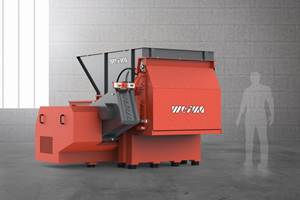Plastics and Legislation: What You Need to Know
From NAFTA to tax reform to LOTO. As NPE2018 approaches, there’s a lot happening on Capitol Hill that plastics processors and suppliers alike should know. Here’s a look at some key issues.
There’s always something gone in Washington. So it’s no surprise that as NPE2018 approaches, there is plenty of stuff percolating on Capitol Hill of interest to plastics. To get a handle on some of the more pressing matters, Plastics Technology magazine caught up with Scott DeFife, v.p. Government Affairs, of the Plastics Industry Association (PLASTICS) to get his read on things.
Here are the highlights:
Plastics Technology: Let’s begin our discussion with NAFTA. Much was said during the presidential campaign about this decades’ old trade agreement and how it was alleged to have displaced U.S. jobs by allowing firms to relocate plants outside the U.S, to Mexico in particular. This is a fluid situation, and last summer The Plastics Industry Association, the Canadian Plastics Industry Association Asociación Nacional de Industrias del Plástico A.C. supporting “modernization of NAFTA to strengthen each nation’s plastics industry.” How important is NAFTA to our industry and what changes to do you see moving forward?
Scott DeFife: NAFTA is extremely important to our members. It was identified as one of the top five priority issues for us to deal with in 2017. That work continues in 2018, as we are now onto the seventh and eight rounds of talks between the countries. The three industry trades were present again at the Montreal round of talks and reiterated the importance of the agreement to negotiators, asking the trade negotiators to provide the business community with some certainty regarding their efforts to strengthen NAFTA. Additionally, we reiterated our support for continuing and strengthening NAFTA, which has the potential to become even more beneficial to each member country’s economy with the right adjustments. The associations pledged to continue to work together with their industry partners to support NAFTA and its successful renegotiation.
PT: Let’s shift to another fluid matter: tax reform. In November PLASTICS President and CEO Bill Carteaux said this: “Earlier this year during the 2017 Plastics Industry Fly-In, men and women from around the country who depend on America’s plastics manufacturing industry came to Washington to advocate for measures that would help create jobs and make their industry more globally competitive. Among those priorities were a lower corporate tax rate, immediate expensing of capital investments and the preservation of the research and development tax credit.” There are a lot of small businesses in plastics that favor tax reform. What do you expect the bill to look like when it reaches the president’s desk and what will the impact be on the plastics industry?
DeFife: PLASTICS was very successful in the most recent tax reform efforts, and our priority issues were included in the final package signed by the president. The law now provides for a 21% corporate rate, while small-businesses have a 20% pass-through rate through 2025. Most critical was a 100% immediate expensing until Jan. 1, 2023 then gradual drawdown through 2026. The law also preserves R&D credit and enhances Section 179 to $1 million with a $2.5 million threshold.
PT: What are the major issues PLASTCS’ will be facing this year that could impact the industry in general and plastics processors in particular. For one, are changes in the offing for the Food Safety Modernization Act of 2011? How does PLASTICS see things shaking out?
DeFife: There are a couple looming issues that we are investigating and working on that could have broad industry impact: infrastructure and marine debris and microplastics. There are several initiatives that we are working in with respect to infrastructure that could be important to long-term growth in the industry. We want to make sure that plastic materials have equal footing and not precluded from being considered for federal, state and local infrastructure projects, especially with pipe projects. We want open competition and a level-playing field for our products so that they can be used when appropriate, saving communities budget when implementing new pipe infrastructure. Furthermore, we see a national effort to improve the nations’ infrastructure as an opportunity to make major investments in recycling capacity and waste management infrastructure.
In addition, we think you will see increasing numbers of academic studies and NGO involvement in the question of plastic materials in marine environments, straws and single-use items, as well as microplastics, and we take these challenges very seriously. The industry does not want to see these materials in the marine environment, but we feel that a more robust waste management infrastructure and significant investments in recycling technology and capacity will go much further toward addressing these issues than product bans.
PT: 2016 saw passage of a bi-partisan TOSCA reform bill, the Frank R. Lautenberg Chemical Safety for the 21st Century. PLASTICS applauded passage of this legislation. Are there any challenges or changes to this law under review now about which the plastics industry should be aware?
DeFife: Passage of the TSCA law was significant, but the details are always laid out in regulations. The Environmental Protection Agency (EPA) has since identified three broad area for regulations under TSCA: how chemicals will be prioritized for risk evaluation, how chemical risk evaluations will be conducted, and to identify chemical substances on the TSCA Inventory that are active in U.S. commerce. Interest groups have filed lawsuits against all three proposals. PLASTICS remains engaged with industry stakeholders, from material suppliers to downstream users, in working to ensure EPA’s rules are consistent with the LCSA (The Frank R. Lautenberg Chemical Safety for the 21st Century Act) and provide the clarity and certainty needed by regulated entities.
PT: Let’s talk about Lock-Out, Tag-Out (LOTO). Back in 2016, the Michigan Occupational Safety and Health Administration (MIOSHA) proposed changes to Part 62 Plastic Molding Safety Standard R408.16234, designed to help it meet OSHA’s General Industry Safety Standard, Part 85 “The Control of Hazardous Energy Sources.” PLASTICS has stated that “OSHA’s proposal would expand the applications in which lockout is required, and would present challenges in demonstrating the efficacy of automated controls that could eliminate the potential for unexpected energization and therefore eliminate the need for LOTO.” While plastics molders hesitate to talk about the impact of any changes on the record, they are clearly concerned that new requirements will considerably lengthen mold-change time.
Where do we stand on this issue?
DeFife: There a couple related issues going on here, we are working on them both in separate efforts. Last year, as a part of a normal standard update process, the Federal Occupational Safety & Health Administration (OSHA) had proposed to remove the word “unexpected” from their general industry federal Lockout Tagout (LOTO) equipment standard. We have had several conversations with OSHA since and are hopeful that they will not remove “unexpected” when they issue the final proposed rules this Spring. [The rules may come out by the time the NPE happens] The first step in any process to update the standards should be to issue a request for information, and PLASTICS will work with our members, OSHA, and other stakeholders on ensuring workers are protected by a standard that accounts for more modern equipment.
Separately, PLASTICS has been working with the Michigan state OSHA, MIOSHA, on updating the state regulatory requirements that currently still require the use of a “jam bar” on horizontal injection mold machines. We have agreement with MIOSHA that they will review their requirement with respect to new federal standards and international developments and are hopeful that we will soon be able to announce that MIOSHA rules will align with international treatment of jam bars, significantly simplifying rules for equipment manufacturers.
PT: Please talk about the resources PLASTICS has available to help the industry what’s going on the regulatory and legislative front, such as Project Passport, the EHS+ Committee, the Food Packaging Coalition, and others?
DeFife: We have a variety of resources for members to use to follow and participate in our work in advocating on behalf of the industry in addition to the technical and tactical committees of the organization such as EHS+ and the FDCPMC. We encourage our members to follow our “Inside Plastics” bi-weekly newsletter. We include all major state and federal legislative and regulatory developments in that electronic memo, and I will be working on a periodic Government Affairs blog that delves deeper into the issues confronting the industry. We have an annual “fly-in” in Washington where we arrange meetings with federal lawmakers and regulators important to the industry, and we are working to double the number of plant and facilities tours that we put together with member companies and state, local and federal policymakers. These are particularly useful for helping to show regulators and elected officials the work that goes on at our member operations and getting a better understanding of the challenges we face.
Related Content
In the Zone: Packaging
The Packaging Zone is the place to learn about the latest in customer product delivery.
Read MoreSix Years in the Waiting, PLASTICS Igniting a ‘Spark’ at NPE
New features of NPE2024 aim to “bring the whole plastics ecosystem together to innovate, collaborate and share findings.”
Read MoreRecycling Partners Collaborate to Eliminate Production Scrap Waste at NPE2024
A collaboration between show organizer PLASTICS, recycler CPR and size reduction experts WEIMA and Conair will seek to recover and recycle 100% of the parts produced at the show.
Read MoreImpacts of Auto’s Switch to Sustainability
Of all the trends you'll see at NPE2024, this one is BIG. Not only is the auto industry transitioning to electrification but there are concerted efforts to modify the materials used, especially polymers, for interior applications.
Read MoreRead Next
Processor Turns to AI to Help Keep Machines Humming
At captive processor McConkey, a new generation of artificial intelligence models, highlighted by ChatGPT, is helping it wade through the shortage of skilled labor and keep its production lines churning out good parts.
Read MoreWhy (and What) You Need to Dry
Other than polyolefins, almost every other polymer exhibits some level of polarity and therefore can absorb a certain amount of moisture from the atmosphere. Here’s a look at some of these materials, and what needs to be done to dry them.
Read More
















.png;maxWidth=300;quality=90)











